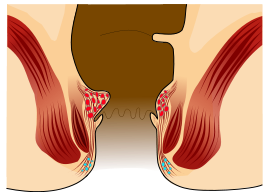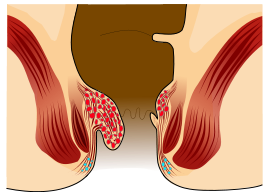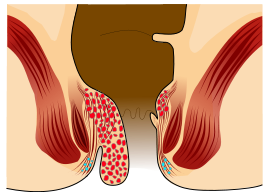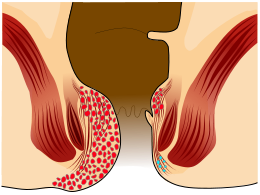Hemorrhoids are swollen veins around the anal canal. To determine if it is really hemorrhoids, you must know what it looks like. At the early stages, it is hard to determine since its symptoms may be similar to other medical conditions. Usually, the initial symptoms are bloating and painful bowel movement.
Hemorrhoids can be described as cushions or masses of swollen veins in the anal area. The external type occurs in the lower area of the anal canal, near the anus. The Internal type, on the other hand, occurs on top of the anal canal, on the rectal side.
External hemorrhoids are soft lumps of swollen veins that appear in bunches. When this external type is thrombosed, the mass of swollen veins may become hard and cause pain when sitting, walking or during bowel movement. The internal type is usually not painful but when the lumps bulge from the anus, this is an indication of thrombosis and may cause severe pain.
Click here to get hemorrhoid relief in 48 hours
The piles of swollen veins can appear to be violet to almost black or pinkish and reddish with mucus covering. This condition is easily damaged and cause bleeding after bowel movement. Constipation may cause prolapsed hemorrhoids that cause pain and bleeding but it typically goes back to place and the pain is also eased.
Stage 3 hemorrhoids involve the loss of nerves. The swollen veins are bulging or hanging from the anus and it causes constant pain, irritation, itching and bleeding. Stage 4 hemorrhoids appear as large lumps covering the entire anus. These are what this disease look like when acute. At this stage, bowel movement is painful and bleeding is constant. Surgery is needed to treat this stage of the ailment.
How to prevent the condition
Hemorrhoids are commonly caused by extreme straining during bowel movement due to constipation or diarrhea. To prevent straining, normal bowel movement is needed. Adding more fiber to your diet will help you maintain a normal bowel movement. Increase your consumption of fruits and vegetables and avoid foods that are salty, oily and fatty.
Keeping yourself rehydrated at all times is also very helpful. Drinking more fluid helps pass the stool easily and prevent constipation. Too much pressure on the anal area also affects the blood flow which causes the veins to swell. To prevent this from happening, avoid lifting heavy objects. If your work requires you to sit for a long time, try to move from one position to another from time to time. You may also sit on cushions to reduce the pressure on your anus.
To relieve the pain, irritation and discomfort due to the hemorrhoidal disease, topical treatments are available and they are readily available. They may not cure your hemorrhoids entirely but they can offer instant relief with the itch and pain associated with it.
Now that you know what do hemorrhoids look like and how to treat them, you can effectively manage its symptoms and treat your condition before it becomes severe. Hemorrhoids can be very annoying and frustrating but you can do something about it.
4 grades of internal hemorrhoids
Hemorrhoids are vascular structures lining the rectum. It is a network of arteries, veins and capillaries that help control the passage of stool from the body. It also serves as a cushion in its physiological state.
Pathological hemorrhoids develop mainly due to the presence of increased pressure inside the rectum. This occurs during diarrhea and/or constipation, where the individual has to strain in order to expel his/her feces. Other conditions also contribute to hemorrhoids like pregnancy and childbirth (the increasing size of the fetus constricts the rectum), lack of exercise (which contributes to poor bowel movement), diet low in fiber (this will make the stool more compact and more difficult to pass), aging (generally makes the sphincter muscles weaker), and genetics (pathological hemorrhoids run in the family).
Click here to get hemorrhoid relief in 48 hours
Because of the increased pressure in the rectum, the blood vessels become inflamed and swollen. They are also more sensitive to touch, making them painful and/or itchy as well. In some cases, the pressure inside the rectum is too high that the hemorrhoid is forced out of the anus (this will be explained later). This will expose the already sensitive tissue to the environment outside the body where it is at a greater risk of being more irritated.
Symptoms of pathological hemorrhoids are the following: itching, pain, lump on the anus, swelling and the presence of blood upon defecation. The diagnosis is usually done during physical examination. It can become evident during mere observation of the anus or a more specific rectal exam to differentiate pathological hemorrhoids from other rectal diseases such as cancer or tumors.
Pathological hemorrhoids can be classified as external or internal. External hemorrhoids are those located distally to the dentate or pectinate line, which is a line dividing the upper 2/3 from the lower 1/3 of the anal canal. External hemorrhoids are covered with sensate squamous epithelium, so when the tissue gets inflamed, the patient would most likely report pain, itching, and swelling. They are also more prone to thrombosing (blood clot formation). This haemorrhoid type is usually the one presenting as a sensitive lump outside the anus.
Internal hemorrhoids, on the other hand, are those forming proximal to the dentate or pectinate line. The area is covered with insensate columnar-glandular epithelium that is susceptible to prolapsing. Patient would usually experience a sudden bleeding without any pain after a bowel movement.
The different grades of internal hemorrhoids are classified according to the severity and location of the haemorrhoid tissue and the relative treatment patients receive.
The following will discuss the grades of internal hemorrhoids:
 attribution: Armin Kübelbeck galerie.hbz-da.de
attribution: Armin Kübelbeck galerie.hbz-da.de
Grade 1 (Primary). These are hemorrhoids located below the dentate line. It doesn’t protrude from the anal canal but may cause associated symptoms like bleeding or itching. These are often managed through dietary changes.
 attribution: Armin Kübelbeck galerie.hbz-da.de
attribution: Armin Kübelbeck galerie.hbz-da.de
Grade 2 (Secondary). These are already considered as the first stage of prolapse. The hemorrhoid protrudes from the canal during defecation but retracts right after. These are treated with sclerotic therapy or rubber banding.
 attribution: Armin Kübelbeck galerie.hbz-da.de
attribution: Armin Kübelbeck galerie.hbz-da.de
Grade 3 (Tertiary). These cannot retract back to its original formation and must be reduced manually. Patients may already be advised for surgery.
 attribution: Armin Kübelbeck galerie.hbz-da.de
attribution: Armin Kübelbeck galerie.hbz-da.de
Grade 4 (Quaternary). These final grades of internal hemorrhoids are already prolapsed and should be surgically removed.


